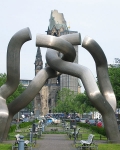Berlin
Archaeology »
Archaeological Monuments » Berlin
Berlin - Germany
Berlin is located in Berlin,Tauentzienstraße.
Berlin monument was established on 1987.
Primary threats to Berlin :
The Matschinsky-Denninghoffs chose the Tauentzienstrabe in front of the Kaiser-Wilhelm-Gedachtniskirche, which was heavily damaged during the Bombing of Berlin in World War II, as the place to build and unveil their sculpture.
Historical facts of Berlin :
- Berlin, the capital city of Germany, is a city rich in history and has played a significant role in shaping the course of European and world events. From its origins as a small medieval trading town to its division and subsequent reunification during the Cold War, Berlin's historical journey is both fascinating and complex.
- The earliest recorded settlement in the area that is now Berlin dates back to the 13th century when it was founded as a trading post on the banks of the River Spree. Over time, Berlin grew in importance as a regional center, and in 1415 it became the capital of the Margraviate of Brandenburg. The city flourished during the Renaissance and the following centuries, attracting artists, scientists, and intellectuals.
- In the 18th century, Berlin experienced a period of significant transformation under the rule of Frederick the Great, who was the King of Prussia. Frederick turned Berlin into a hub of cultural and intellectual activity, inviting scholars, musicians, and architects to the city. Notable landmarks such as the Brandenburg Gate and the Unter den Linden boulevard were constructed during this time, contributing to Berlin's architectural grandeur.
- In the 19th century, Berlin's population exploded as industrialization took hold, and the city became the capital of the newly united German Empire in 1871. It rapidly developed into a major economic, political, and cultural center, attracting immigrants from all over Europe. The population growth and urbanization led to the expansion and modernization of Berlin's infrastructure, with the construction of railways, factories, and public buildings.
- The early 20th century witnessed both great achievements and immense challenges for Berlin. The city became renowned for its vibrant arts scene, with the birth of the avant-garde movement known as the Berlin Secession and the establishment of the groundbreaking Bauhaus school. However, World War I and its aftermath brought political instability and economic hardship to the city and the rest of Germany.
- The turbulent years of the Weimar Republic followed, marked by political unrest, social upheaval, and economic crises. Berlin, in particular, experienced a cultural boom known as the "Golden Twenties." The city became a center of innovation, with flourishing nightlife, cabaret, and progressive social movements. However, this era was short-lived, and the rise of Adolf Hitler and the Nazi party in the early 1930s would plunge Berlin and Germany into one of the darkest periods in history.
- During World War II, Berlin suffered extensive damage from Allied bombing raids, and in 1945, the city was divided into four sectors by the victorious Allied powers— the United States, the Soviet Union, the United Kingdom, and France. Tensions between the Soviet Union and the other Allied powers escalated, leading to the construction of the Berlin Wall in 1961, which physically divided the city and symbolized the broader division between East and West during the Cold War.
- The Berlin Wall stood as a stark reminder of the ideological and political divisions of the Cold War era until its fall on November 9, 1989. The reunification of East and West Germany followed, and Berlin once again became the capital of a unified Germany. This historic event marked a turning point in world history and brought significant changes to Berlin's urban landscape and cultural fabric.
- Since reunification, Berlin has undergone rapid transformation, with extensive reconstruction, new architectural projects, and the revitalization of neglected neighborhoods. It has reemerged as a thriving international metropolis, known for its vibrant arts scene, innovative startups, and cultural diversity. Landmarks such as the Reichstag building, the Berlin Wall Memorial, and the Potsdamer Platz symbolize the city's turbulent history and its journey towards reconciliation and unity.
- In conclusion, Berlin's history spans centuries of growth, turmoil, division, and reunification. From its humble origins as a trading town to its role as the capital of a unified Germany, Berlin has witnessed and shaped significant historical events. The scars of war and the struggles of division are evident in the city's physical and cultural landscape, but today, Berlin stands as a symbol of resilience, creativity, and the power of human determination.

